Kingsnake
Kingsnakes are colubrid New World constrictors, members of the genus Lampropeltis, which includes milk snakes and four other species. Among these, about 45 subspecies are recognized. They are non-venomous snakes and are ophiophagous in diet.
| Kingsnakes | |
|---|---|
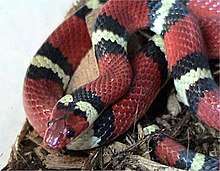 | |
| Scarlet kingsnake (Lampropeltis elapsoides) | |
| Scientific classification | |
| Kingdom: | Animalia |
| Phylum: | Chordata |
| Class: | Reptilia |
| Order: | Squamata |
| Suborder: | Serpentes |
| Family: | Colubridae |
| Tribe: | Lampropeltini |
| Genus: | Lampropeltis Fitzinger, 1843 |
| Synonyms | |
|
Ablabes, Anguis, Bellophis, Calamaria, Coronella, Herpetodryas, Natrix, Ophibolus, Osceola, Phibolus, Pseudelaps, Zacholus[2] | |
Etymology
Lampropeltis includes the Greek words for "shiny shield":[3] λαμπρός lampro(s) ("shiny") + πέλτη pelt(ē) ("peltē shield") + -is (a Latin suffix).
The name is given to them in reference to their smooth, enamel-like dorsal scales.[4]
Their common name of "kingsnake" derives from their habit of eating other snakes (such as rattlesnakes)
Range and morphology
Kingsnake species inhabit the Americas from southeastern Canada to southern Ecuador. The several species vary widely in size and coloration. Adult scarlet kingsnakes are typically 40 to 50 cm (16 to 20 in) in length, while the common kingsnake can grow to 1.8 m (6 ft). Some kingsnakes are colored in muted browns to black, while others are brightly marked in white, reds, yellows, grays, and lavenders that form rings, longitudinal stripes, speckles, and saddle-shaped bands.[5]
Behavior and diet
Kingsnakes use constriction to kill their prey and tend to be opportunistic in their diet; they eat other snakes (ophiophagy), including venomous snakes. Kingsnakes also eat lizards, rodents, birds, and eggs.[6] The common kingsnake is known to be immune to the venom of other snakes and does eat rattlesnakes, but it is not necessarily immune to the venom of snakes from different localities.[6]
The "king" in the name (as with the king cobra) refers to its preying on other snakes.[7]
Kingsnakes such as the California kingsnake can exert twice as much constriction force relative to body size as rat snakes and pythons. Scientists believe such strong coils may be an adaptation to snake and other reptile prey, which can sustain lower blood-oxygen levels before asphyxiating.[8]
Description
Most kingsnakes have quite vibrant patterns on their skins. Some species, such as the scarlet kingsnake, Mexican milk snake, and red milk snake, have coloration and patterning that can cause them to be confused with the highly venomous coral snakes.
One of the mnemonic rhymes to help people distinguish between the coral snake and its nonvenomous lookalikes in the United States is "Red on black, friend of Jack; red on yellow, kill a fellow." Other variations include "Red on yellow kill a fellow. Red on black venom lack."[9][10] and "Yellow, red, stop!", referencing the order of traffic lights. Both mnemonics apply only to coral snakes native to North America: Micrurus fulvius (the eastern or common coral snake), Micrurus tener (the Texas coral snake), and Micruroides euryxanthus (the Arizona coral snake), found in the southeastern and southwestern United States. Coral snakes found in other parts of the world can have distinctly different patterns, have red bands touching black bands, have only pink and blue bands, or have no bands at all.
Taxonomy
Taxonomic reclassification of the kingsnakes is an ongoing process and different sources often disagree, one source granting full species status to a group of these snakes that another source considers a subspecies group. In the case of Lampropeltis catalinensis, for example, only a single specimen exists, so classification is not necessarily finite. In addition, hybridization between species with overlapping geographic ranges is not uncommon, confusing taxonomists further.
Predators
Kingsnakes are often preyed upon by large vertebrates, such as birds of prey. Tarantulas also sometimes prey on them.[11]
List of kingsnake species and subspecies
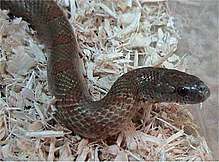
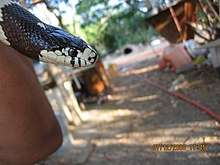
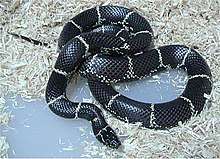
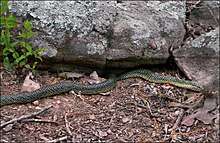
Kingsnake species and subspecies include (listed here alphabetically by specific and subspecific name):[12]
- Guatemalan milk snake, Lampropeltis abnorma (Bocourt, 1886)
- Gray-banded kingsnake, Lampropeltis alterna (A. E. Brown, 1901)
- Mexican milk snake, Lampropeltis annulata Kennicott, 1860
- California kingsnake, Lampropeltis californiae (Blainville, 1835)
- Prairie kingsnake, Lampropeltis calligaster (Harlan, 1827)
- Prairie kingsnake, L. c. calligaster (Harlan, 1827)
- South Florida mole kingsnake, L. c. occipitolineata Price, 1987
- Mole kingsnake, L. c. rhombomaculata (Holbrook, 1840)
- Santa Catalina Island kingsnake, Lampropeltis catalinensis (Van Denburgh & Slevin, 1921)
- Scarlet kingsnake or scarlet milk snake, Lampropeltis elapsoides (Holbrook, 1838)
- Short-tailed snake, Lampropeltis extenuata (Brown, 1890)
- Central Plains milk snake, Lampropeltis gentilis (Baird & Girard, 1853)
- Common kingsnake, Lampropeltis getula (Linnaeus, 1766)
- Brooks' kingsnake, L. g. brooksi Barbour, 1919
- Florida kingsnake, L. g. floridana (Blanchard, 1919)
- Eastern kingsnake, L. g. getula (Linnaeus, 1766)
- Apalachicola kingsnake, L. g. meansi Krysko & Judd, 2006
- Mexican black kingsnake, L. g. nigrita Zweifel & Norris, 1955
- Greer's kingsnake, Lampropeltis greeri (Webb, 1961)
- Speckled kingsnake, Lampropeltis holbrooki Stejneger, 1902
- Madrean mountain kingsnake, Lampropeltis knoblochi Taylor, 1940
- Nuevo León kingsnake, Lampropeltis leonis (Günther, 1893)
- Mexican kingsnake, Lampropeltis mexicana (Garman, 1884)
- Mexican kingsnake, L. m. mexicana (Garman, 1884)
- Ecuadorian milk snake, Lampropeltis micropholis Cope, 1860
- Black kingsnake, Lampropeltis nigra (Yarrow, 1882)
- Atlantic Central American milk snake, Lampropeltis polyzona Cope, 1860
- Arizona mountain kingsnake, Lampropeltis pyromelana (Cope, 1866)
- Utah mountain kingsnake, L. p. infralabialis W. W. Tanner, 1953
- Arizona mountain kingsnake, L. p. pyromelana (Cope, 1866)
- Ruthven's kingsnake, Lampropeltis ruthveni (Blanchard, 1920)
- Desert kingsnake, Lampropeltis splendida (Baird & Girard, 1853)
- Eastern milk snake, Lampropeltis triangulum (Lacépède, 1789)
- Lampropeltis webbi Bryson, Dixon & Lazcano, 2005
- California mountain kingsnake, Lampropeltis zonata (Lockington, 1876 ex Blainville, 1835)
- San Pedro kingsnake, L. z. agalma (Van Denburgh & Slevin, 1923)
- Todos Santos Island kingsnake, L. z. herrerae (Van Denburgh & Slevin, 1923)
- Sierra Nevada mountain kingsnake, L. z. multicincta (Yarrow, 1882)
- Coast Ranges mountain kingsnake, L. z. multifasciata (Bocourt, 1886)
- San Bernardino mountain kingsnake, L. z. parvirubra Zweifel, 1952
- San Diego mountain kingsnake, L. z. pulchra Zweifel, 1952
- Saint Helena mountain kingsnake, L. z. zonata (Lockington, 1876 ex Blainville, 1835)
Additionally, Pyron and Burbrink have argued that the short-tailed snake (Stilosoma extenuatum) (Brown, 1890) should be included with Lampropeltis.[13]
References
- "Fossilworks: Lampropeltis".
- Wright, A. H., and A. A. Wright. (1957). Handbook of Snakes of the United States and Canada. Comstock. Ithaca and London. 1,105 pp. (in 2 volumes) (Genus Lampropeltis, p. 330.)
- "Lampropeltis". Merriam-Webster Dictionary.
- Tennant, Alan (2006). Lone Star Field Guide to Texas Snakes. Taylor Trade Publishing. p. 193. ISBN 978-1-4616-3564-2.
the smooth dorsal scales have an enamel-like surface to which the genus' Latin name, Lampropeltis, or "shining skin shield," refers.
- Powell, Robert; Conant, Roger; Collins, Joseph T. (2016). Peterson Field Guide to Reptiles and Amphibians of Eastern and Central North America, Fourth Edition. Houghton Mifflin Harcourt. pp. 375–381. ISBN 978-0544662-490.
- Conant, R. (1975). A Field Guide to Reptiles and Amphibians of Eastern and Central North America, Second Edition. Houghton Mifflin. Boston. 429 pp.
ISBN 0-395-19977-8 (paperback). (Genus Lampropeltis, p. 201.) - "King snake vs Rattlesnake Oro Valley Az". 2015-12-12.
- "Snake Kills Bigger Snakes with World's Most Powerful Squeeze". 2017-03-15.
- Life's Better Outdoors, South Carolina Department of natural resources Archived 2015-06-30 at the Wayback Machine (see FAQ's. -- "are there any visual clues"). Retrieved July 15, 2015
- Medical-Surgical Nursing: Patient-Centered Collaborative Care by Donna D. Ignatavicius, M. Linda Workman (pages 141-142)
- https://www.youtube.com/watch?v=0NDf2J5Mmjo
- Genus Lampropeltis at The Reptile Database
- Pyron, R. Alexander; Frank T. Burbrink. (2009). "Neogene diversification and taxonomic stability in the snake tribe Lampropeltini (Serpentes: Colubridae)". Molecular Phylogenetics and Evolution 52(#2):524-529.
Further reading
- Hubbs, Brian (2009). Common Kingsnakes: A Natural History of Lampropeltis getula. Tricolor Books, Tempe, Arizona
External links
| Wikimedia Commons has media related to Lampropeltis. |
- Desert USA: Common Kingsnake
- Caring for a Common Kingsnake
- Common Kingsnake - Lampropeltis getula Species account from the Iowa Reptile and Amphibian Field Guide
- Kingsnake eating a garter snake
- King Snake Care Sheet